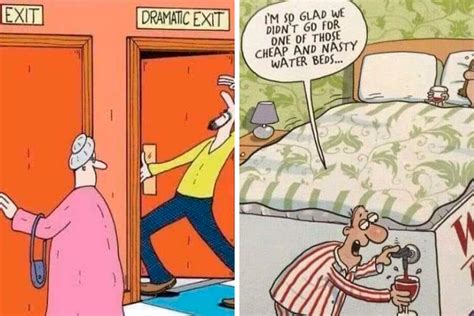
A collection of viral social media posts dubbed “Boomer Humor” has sparked online reactions, showcasing a range of jokes and perspectives that some find endearingly bad while others consider out-of-touch. The posts, highlighted in a recent online compilation, exemplify a specific style of humor often associated with the Baby Boomer generation, characterized by simplistic jokes, outdated references, and occasionally, tone-deaf observations.
The compilation, featured on various social media platforms, includes 19 examples of these posts, ranging from image macros with corny captions to status updates reflecting particular generational viewpoints. According to Yahoo Lifestyle, these posts “felt weirdest, wildest,” capturing the essence of Boomer humor in its most exaggerated form.
The phenomenon raises questions about generational differences in humor, the evolving landscape of online communication, and the potential for miscommunication across demographic groups. While some internet users find the humor harmless and even nostalgic, others criticize it for perpetuating stereotypes and lacking self-awareness. The debate underscores the complexities of online discourse and the challenges of bridging generational divides in the digital age.
The Content of the Posts
The compilation showcases a variety of comedic attempts, frequently relying on visual puns, boomer stereotypes, and commentary on modern society. One prevalent theme involves mocking younger generations, often through sarcastic or condescending remarks about their lifestyles, technology use, or work ethic. These posts tend to use simplistic language and imagery, relying on easily digestible formats like image macros with bold text.
Another common element is the use of outdated references and cultural touchstones. Jokes referencing historical events, vintage advertisements, or obsolete technology are common, often failing to resonate with younger audiences unfamiliar with the context. This can contribute to the perception of Boomer humor as out-of-touch and irrelevant.
Furthermore, some posts feature observations about everyday life that strike some as tone-deaf or insensitive. These can include complaints about minor inconveniences, generalizations about entire groups of people, or expressions of privilege that fail to acknowledge systemic inequalities. Such posts often elicit criticism for lacking empathy and perpetuating harmful stereotypes.
It is important to note that not all Boomer humor falls into these categories, and many individuals from the Baby Boomer generation possess a diverse and nuanced sense of humor. However, the compilation specifically targets the type of humor that has become associated with the “Boomer” label online, often used derisively to describe perceived insensitivity, lack of awareness, or outdated views.
Generational Divide and Online Communication
The popularity of “Boomer Humor” as a subject of online discussion reflects a broader generational divide in online communication. Different generations have grown up with varying access to technology, exposure to different forms of media, and distinct cultural experiences. This leads to differences in communication styles, humor preferences, and understanding of online etiquette.
Baby Boomers, who came of age before the widespread adoption of the internet, may approach online communication differently than Millennials or Gen Z, who have grown up with digital technology as an integral part of their lives. This can result in misunderstandings and misinterpretations, as different generations may have different expectations about tone, context, and appropriate subject matter.
Furthermore, the anonymity and lack of nonverbal cues in online communication can exacerbate these differences. Without the benefit of face-to-face interaction, it can be difficult to discern intent or detect sarcasm, leading to misinterpretations and potentially offensive exchanges.
The “Boomer Humor” phenomenon highlights the importance of understanding generational differences in online communication and practicing empathy when interacting with individuals from different age groups. While humor can be a powerful tool for connection and community building, it can also be a source of conflict and division if not used thoughtfully and respectfully.
The Evolution of Humor and Social Commentary
Humor is constantly evolving, reflecting societal changes, cultural shifts, and technological advancements. What was considered funny or acceptable in one era may be considered offensive or outdated in another. The rise of social media has accelerated this process, allowing for rapid dissemination of new forms of humor and facilitating instant feedback from a global audience.
“Boomer Humor,” as a specific genre, is partly defined by its contrast to contemporary comedic trends. Modern humor often relies on irony, self-deprecation, and social commentary, addressing complex issues in a nuanced and often subversive way. In contrast, “Boomer Humor” often appears more straightforward, simplistic, and less concerned with social commentary.
This contrast is not necessarily a reflection of inherent superiority or inferiority, but rather a product of different historical and cultural contexts. Baby Boomers grew up in a different world, with different values and different experiences. Their humor reflects those differences, and it is important to understand the historical context when evaluating its relevance or appropriateness.
Furthermore, the term “Boomer Humor” has become loaded with negative connotations, often used as a shorthand for perceived generational failings. This can make it difficult to engage in constructive dialogue about generational differences in humor and communication, as the term itself can be seen as pejorative and dismissive.
The Role of Stereotypes
Stereotypes play a significant role in shaping perceptions of “Boomer Humor.” The stereotype of the out-of-touch, technologically inept, and politically conservative Baby Boomer is often invoked when discussing this type of humor, reinforcing negative generalizations and hindering productive conversation.
While stereotypes can be based on real observations, they are often exaggerated and oversimplified, failing to capture the diversity and complexity of individual experiences. Attributing specific characteristics or behaviors to an entire generation is inherently problematic, as it ignores the vast range of individual differences within that group.
In the case of “Boomer Humor,” stereotypes can lead to unfair and inaccurate assessments of individual posts. A joke that might be seen as harmless or even clever if made by someone from a different generation can be automatically labeled as “Boomer Humor” and dismissed as insensitive or outdated.
It is important to be aware of the role of stereotypes in shaping our perceptions of “Boomer Humor” and to avoid making generalizations about entire groups of people based on limited information. Judging individuals based on their generational affiliation rather than on their individual merits can perpetuate harmful stereotypes and hinder meaningful communication.
The Impact of Social Media Algorithms
Social media algorithms play a significant role in shaping the visibility and virality of “Boomer Humor.” These algorithms prioritize content that is likely to generate engagement, such as likes, comments, and shares. This can lead to the amplification of specific types of humor that resonate with certain demographic groups, while other types of humor may be less visible.
In the case of “Boomer Humor,” algorithms may favor posts that are controversial or that provoke strong reactions, as these are more likely to generate engagement. This can lead to the creation of echo chambers, where individuals are primarily exposed to content that confirms their existing beliefs and reinforces their prejudices.
Furthermore, algorithms can also reinforce stereotypes by targeting users with content that is based on their demographic data. If a user is identified as being a member of a particular generation, they may be more likely to see content that is associated with that generation, even if they do not personally identify with it.
The impact of social media algorithms on the spread of “Boomer Humor” highlights the importance of being critical consumers of online content. It is important to be aware of how algorithms shape our online experiences and to seek out diverse perspectives and sources of information. Relying solely on social media feeds for news and information can lead to a distorted view of reality and can reinforce harmful stereotypes.
The Broader Cultural Significance
The “Boomer Humor” phenomenon reflects a broader cultural conversation about generational differences, social change, and the evolving nature of humor. It highlights the challenges of navigating a rapidly changing world and the potential for miscommunication and conflict across demographic groups.
While “Boomer Humor” is often criticized for being out-of-touch or insensitive, it also serves as a reminder of the importance of understanding different perspectives and appreciating the diversity of human experience. Humor can be a powerful tool for bridging divides and building empathy, but it requires sensitivity, awareness, and a willingness to engage in constructive dialogue.
The ongoing discussion about “Boomer Humor” underscores the need for greater understanding and respect across generations. By engaging in open and honest conversations about our differences, we can learn from each other, challenge our assumptions, and build a more inclusive and equitable society.
The Future of Generational Humor
The future of generational humor is likely to be shaped by ongoing technological advancements, cultural shifts, and demographic changes. As new generations come of age and enter the digital landscape, they will bring with them their own unique perspectives, humor preferences, and communication styles.
It is likely that the concept of “Boomer Humor” will continue to evolve, as the Baby Boomer generation ages and their influence on popular culture wanes. However, the underlying themes of generational difference, social commentary, and the evolving nature of humor are likely to remain relevant for years to come.
As we move forward, it is important to approach generational humor with curiosity, empathy, and a willingness to learn from each other. By embracing the diversity of human experience and engaging in constructive dialogue, we can create a more inclusive and understanding society.
FAQ Section
Q1: What exactly is “Boomer Humor?”
A1: “Boomer Humor” refers to a style of humor often associated with the Baby Boomer generation. It’s characterized by simplistic jokes, outdated references, image macros with corny captions, and sometimes, observations that can be perceived as out-of-touch or insensitive by younger generations. It often involves mocking younger generations or using outdated cultural touchstones.
Q2: Why is “Boomer Humor” often criticized?
A2: It’s criticized for several reasons. Some find it insensitive, tone-deaf, or lacking self-awareness. Others criticize it for perpetuating stereotypes about younger generations or for failing to recognize systemic inequalities. The humor can also be seen as outdated or irrelevant due to its reliance on references that younger audiences may not understand. The term itself has also become pejorative, adding to the negative association.
Q3: Is all humor from Baby Boomers considered “Boomer Humor?”
A3: No, not at all. The term “Boomer Humor” is specifically used to describe a particular style of humor, often perceived as simplistic, outdated, or insensitive. Many individuals from the Baby Boomer generation have a diverse and nuanced sense of humor that doesn’t fit this stereotype. The label is often applied selectively to posts that exhibit certain characteristics, regardless of the actual creator’s age.
Q4: How do social media algorithms contribute to the perception and spread of “Boomer Humor?”
A4: Social media algorithms prioritize content that generates engagement. This can amplify controversial or polarizing posts, including examples of “Boomer Humor” that provoke strong reactions. Algorithms can also create echo chambers, exposing users primarily to content that confirms their existing beliefs and stereotypes. Furthermore, targeted advertising based on demographic data can reinforce generational stereotypes by showing specific types of content to users based on their age.
Q5: What can be done to bridge the generational divide in humor and online communication?
A5: Several approaches can help bridge the gap. Practicing empathy and understanding different perspectives is crucial. Being aware of generational differences in communication styles and humor preferences can prevent misunderstandings. Avoiding stereotypes and generalizations is essential. Engaging in open and honest conversations about our differences and being willing to learn from each other can promote understanding and respect. Critically evaluating online content and seeking out diverse perspectives can also combat the effects of echo chambers and algorithmic bias. Learning to recognize satire and nuance is also helpful.









